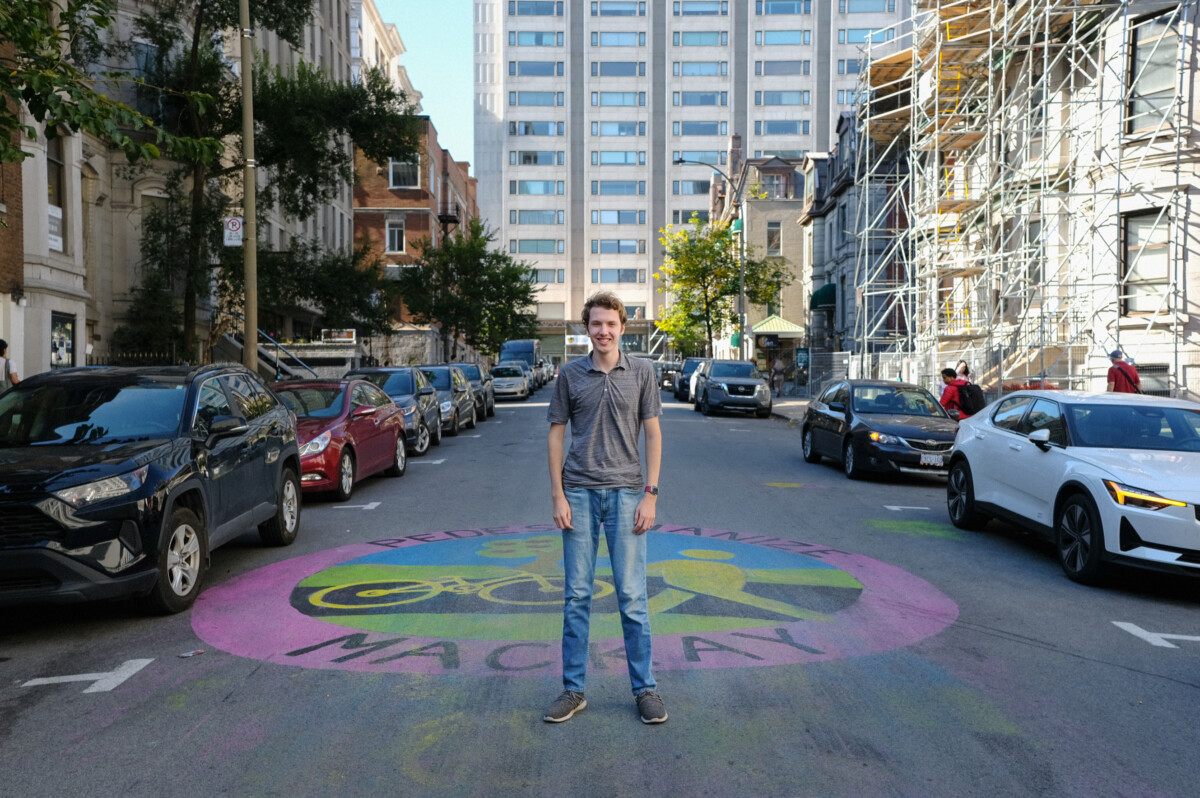From changing public transport signage to blocking off Mackay street to cars, Concordia student Dashiell Friesen wants to bring change to Montreal’s streets.
In the early hours of Sept. 29, Mackay Street, located on Concordia’s Sir George Williams campus, was blocked off by students demanding the road’s pedestrianisation.
Running up and down the street throughout the protest was Dashiell Friesen, one of Pedestrianise Mackay’s coordinators. Directing traffic away from the street and helping his peers paint a mural, Friesen found himself in an uncertain, yet exciting new situation.
“I’ve never done a project like this to this size,” Friesen said in reference to the mural. “It’s been an experience seeing it being created, [Mackay] being blocked off… […] It’s changed my perspective on protests.”
Friesen is a fourth-year student in design at Concordia and a long-time advocate for increased public infrastructure.
Growing up in the heart of New York, he said he experienced the utility of public transportation. Its proximity and ease of access was a gateway into independence in his teenage years. Friesen’s fascination for public transportation grew over the years, eventually leading him to apply his passions into real-life action such as the Mackay Street blockage.
Friesen has been coordinating efforts to pedestrianise Mackay Street since the past summer. First, his plans focused on transforming Bishop Street, as it already gives priority to pedestrians. However, he soon set his sights on Mackay Street, as he thought it served as a better equivalent to McGill University’s pedestrianised McTavish Street.
“There’s such a limited amount of space available, without tearing all the buildings down,” Friesen explained. “I think that’s what I appreciate the most with Montreal, it’s that there’s just more public space to just hang out.”
Friesen said he envisioned a pedestrianised Mackay having walking space above all, as well as seating areas and a garden.
The Mackay Street protest was not achieved solely through Friesen’s efforts. Alongside him was Lily Charette, mobilisation coordinator for the Arts and Science Federation of Associations (ASFA). Advocating for various causes during her time at Concordia, Charette is no stranger to researching and bringing a protest to fruition.
“Dashiell was someone I would always talk to about [Mackay],” Charette said. “There was never really a big push for it, it was always pushed to the side in the past. He was really passionate about the project.”
The pair worked together to bring this project in the limelight. Where Charette hosted meetings and came up with a plan of action, Friesen would plan out mock-up models and write proposals to involved authorities such as Concordia’s administration or to the city.
Last summer, Friesen installed signage stickers for Réseau Express Métropolitain (REM) access at Bonaventure and Gare Centrale stations, days prior the Autorité Régionale de Transport Métropolitain (ARTM).
While passing through stations, he noticed there were no clear directions guiding travellers to the new REM trains. Friesen utilised his background in design in order to print his own signs based on the city’s previous designs for other modes of transport.
After initially reaching out to the ARTM about changing the signage, Friesen’s efforts came to light thanks to news outlets. This, alongside his own efforts to contact the ARTM, prompted them to install clearer signage for the REM.
“I don’t typically love participating in protests, I’m fine just seeing them. But I wanted to still be involved in advocating for something in the city,” Friesen explained. “In a way, protesting was me installing my own signs, or you know, getting a huge group of people to block a street.”
Emboldened by the change he’d been part of with the REM signage, Friesen decided to tackle pedestrianising Mackay Street. “My whole motive is to just give back in general,” Friesen said.
In the weeks since the street blockage, the painted mural has remained on Mackay Street. Friesen said he has received good news regarding the city’s plans for Mackay Street. However, he said his cohort’s job is far from over, as they’ll have to keep raising awareness in order to fuel the conversation they’ve started in Concordia’s halls.
Mackay Street and the Hall Building.
Photo by Lily Cowper / The Concordian
